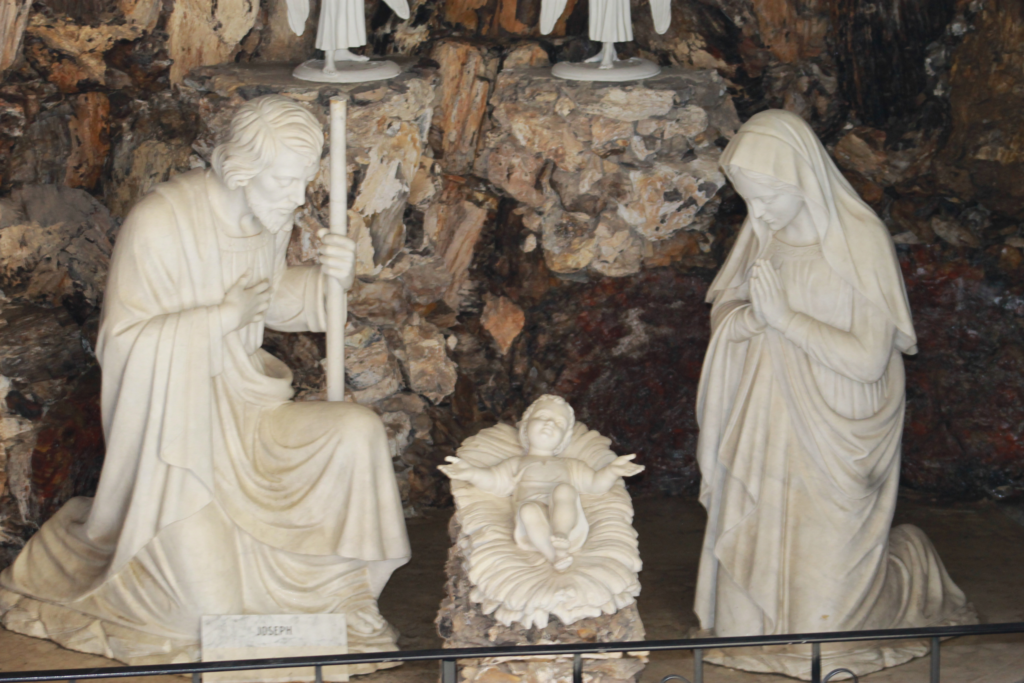The 33-day Marian consecration to the Blessed Virgin Mary is a spiritual practice rooted in the Catholic tradition, calling believers to dedicate themselves to Jesus through Mary. This devotion, as outlined by Saint Louis de Montfort in his classic work True Devotion to Mary (affiliate), has gained significant traction among Catholics who desire a deeper union with Christ through His Mother. The practice typically culminates on a Marian feast day, making it a special offering of love and commitment to both Jesus and Mary.
This blog post will explore the theological foundation, historical significance, and practical aspects of the 33-day consecration, as well as provide guidance on how to embark on this transformative spiritual journey.
The Theological Foundation of Marian Consecration
At the heart of the 33-day consecration is the recognition of Mary’s unique role in the economy of salvation. Catholics believe that Mary is not only the Mother of God but also a powerful intercessor and spiritual mother to all Christians. Through her “yes” to God, she became the vessel through which Christ entered the world.
Saint Louis de Montfort, one of the Church’s most ardent Marian advocates, emphasized that true devotion to Mary ultimately leads to a closer relationship with Jesus Christ. His teachings are built on the understanding that Mary, being free from sin and perfectly obedient to God’s will, can help guide believers to a deeper relationship with her Son. As Montfort explained in True Devotion to Mary, consecrating oneself to Mary means entrusting her with one’s entire life, so that she may lead the soul more perfectly to Christ.
The Historical Development of the Consecration
The 33-day consecration to Mary has its origins in the writings and teachings of Saint Louis de Montfort (1673–1716). His True Devotion to Mary, written in 1712, outlines a method of total consecration, which he believed was the surest way to become a true disciple of Christ. Montfort taught that consecrating oneself to Jesus through Mary allows the faithful to live in greater imitation of Christ’s humility, obedience, and love.
Though Montfort’s teachings were not immediately recognized during his lifetime, his work gained widespread popularity after it was rediscovered in the 19th century. Pope Pius IX was a strong supporter of Montfort’s Marian devotion, and subsequent popes, including Pope Leo XIII, Pope St. Pius X, and Pope St. John Paul II, encouraged the faithful to embrace Montfort’s consecration. Pope St. John Paul II, in particular, had a deep personal devotion to Montfort’s teachings, even adopting the papal motto Totus Tuus (“Totally Yours”), reflecting his own Marian consecration.
The Structure of the 33-Day Consecration
The 33-day consecration is a spiritual preparation that culminates in an act of total consecration to Jesus through Mary. It involves daily prayers, reflections, and meditations, often divided into four key phases:
- Twelve Preliminary Days: These first twelve days are focused on ridding oneself of the “spirit of the world.” Through prayer, meditation, and self-reflection, the participant seeks to detach from worldly attachments, pride, and sin, preparing the soul for a deeper relationship with Christ through Mary.
- First Week: Knowledge of Self: During this week, the focus is on self-examination, repentance, and humility. The participant prays for the grace to know themselves more deeply, acknowledging personal sins, weaknesses, and areas in need of God’s healing.
- Second Week: Knowledge of Mary: In the second week, the participant contemplates the virtues and life of the Blessed Virgin Mary. Through prayer and reflection, they seek to understand Mary’s role in salvation history and her example of perfect discipleship.
- Third Week: Knowledge of Jesus: The final week is dedicated to deepening the participant’s relationship with Jesus Christ. Through Mary’s intercession, the participant reflects on the life, passion, and love of Christ, with the goal of becoming more united to Him.
On the 34th day, the participant makes the formal act of consecration, often coinciding with a Marian feast day, such as the Feast of the Immaculate Conception or the Annunciation.
The Spiritual Benefits of Consecration
Consecrating oneself to Mary is believed to bring numerous spiritual benefits, including greater protection against sin and temptation, a deeper relationship with Christ, and an increased capacity for virtue. According to Saint Louis de Montfort, those who consecrate themselves to Mary receive her special maternal care, which helps them grow in holiness and remain faithful to God’s will.
Participants in the consecration often report feeling a profound sense of peace and trust, knowing that Mary is guiding them toward a deeper union with her Son. They also find that their prayer life becomes more fruitful, as they seek to imitate Mary’s virtues of humility, purity, and obedience.
How to Begin the 33-Day Marian Consecration
For those interested in beginning the 33-day consecration, there are several resources available. The most traditional method involves reading and following Saint Louis de Montfort’s True Devotion to Mary. Many modern adaptations of Montfort’s work are also available, such as 33 Days to Morning Glory (affiliate) by Fr. Michael Gaitley, which provides a more contemporary approach to the consecration process.
Here are the basic steps to begin:
- Choose a Marian Feast Day: Select a Marian feast day on which you will make your consecration. Some popular options include the Feast of the Immaculate Conception (December 8), the Annunciation (March 25), or the Assumption (August 15).
- Start 33 Days Prior to the Feast Day: Count back 33 days from the feast day you have chosen. This will be the start of your consecration journey.
- Daily Prayer and Reflection: Each day of the consecration involves a set of prayers and meditations. You can use resources like Montfort’s True Devotion to Mary or Gaitley’s 33 Days to Morning Glory to guide your reflections.
- Act of Consecration: On the final day, after completing the 33 days of preparation, make the formal act of consecration. This can be done privately or during a Mass, often with the recitation of a special prayer of consecration.
Personal Reflection

As a personal testimony, I embarked on the 33-day consecration last year during a challenging period of my life, seeking a deeper connection with God. Throughout the consecration, I felt Mary’s presence guiding me closer to her Son. I realized that by entrusting myself to her, I was learning to submit my will more fully to God, just as she did.
This spiritual journey transformed my prayer life. I found myself more at peace, trusting in Mary’s intercession and feeling a greater sense of purpose in my relationship with Christ.
Reconsecrating Yourself to Mary: A Lifelong Commitment
After completing your initial consecration to Jesus through Mary, it’s important to recognize that this is not a one-time event but an ongoing journey of deepening your relationship with Christ. St. Louis de Montfort, who developed the practice of total consecration, encouraged Catholics to regularly renew or “reconsecrate” themselves to Mary. This renewal allows you to reaffirm your commitment to living in the grace of God and following Mary’s guidance on the path to holiness.
Why Reconsecration is Important
Reconsecrating yourself to Mary offers several spiritual benefits:
- Deepening Your Relationship with Christ: Each time you renew your consecration, you’re reminded that Mary’s role is to bring you closer to Jesus. This continual recommitment can lead to a more intimate union with Christ.
- Renewal of Intentions: Life circumstances change, and so do your spiritual needs and intentions. Reconsecrating yourself is an opportunity to renew and refocus your spiritual goals, asking Mary to intercede for you in specific areas of your life.
- Strength for Spiritual Battles: We face constant spiritual battles, and regular reconsecration is a powerful way to draw on Mary’s protection and grace. It strengthens your resolve to resist temptation and remain faithful to God’s will.
- A Deeper Commitment to Holiness: The ongoing process of reconsecration helps you continually orient your life toward sanctity. It serves as a reminder that your relationship with God requires daily dedication, with Mary guiding you in living out your faith.
When to Reconsecrate
Many Catholics choose to reconsecrate themselves to Mary annually, often on a Marian feast day such as the Feast of the Immaculate Conception (December 8) or the Feast of Our Lady of Fatima (May 13). You can follow the same 33-day preparation used for your initial consecration, or you may choose a shorter reflection period. Either way, the act of reconsecration can be a powerful spiritual renewal.
How to Reconsecrate Yourself
- Choose a Feast Day: Begin your preparation in the same way as your initial consecration, timing the 33 days of preparation to culminate on a Marian feast day. Alternatively, some Catholics choose to renew their consecration on the anniversary of their first consecration.
- Daily Prayers and Reflections: You may use resources like St. Louis de Montfort’s True Devotion to Mary (affiliate) or Fr. Michael Gaitley’s 33 Days to Morning Glory (affiliate). These resources provide daily reflections and prayers that focus on deepening your Marian devotion.
- Act of Reconsecration: At the end of your preparation, make a formal act of reconsecration.
- Living Out the Consecration: After reconsecrating yourself, continue living out your consecration daily by honoring Mary through prayer, striving for virtue, and receiving the Sacraments frequently.
Reconsecrating yourself to Mary is a powerful way to sustain your spiritual growth and continue walking on the path to holiness. Through her intercession and motherly care, you can remain firmly rooted in Christ’s love, constantly seeking to live in His grace.
Final Thoughts: Total Consecration as a Path to Holiness
The 33-day Marian consecration is a spiritual journey that deepens your relationship with Christ. As Saint Louis de Montfort taught, total consecration to Mary ultimately leads to greater union with Jesus, as she helps us grow in virtue, humility, and love.
For those seeking to deepen their faith and grow in holiness, the 33-day consecration offers a path of transformation and grace, where Mary gently leads her children closer to her Son, the source of all love and mercy.
Hi there! I'm Jennifer, the heart behind Beloved Catholic. I love diving into our rich Catholic traditions and sharing articles that inspire and uplift. Whether you're looking for insights, encouragement, or just a place to feel at home, I'm so glad you're here!
Beloved Catholic is a participant in the Amazon Services LLC Associates Program, an affiliate advertising program designed to provide a means for sites to earn advertising fees by advertising and linking to Amazon.com. *Amazon and the Amazon logo are trademarks of Amazon.com, Inc., or its affiliates.
